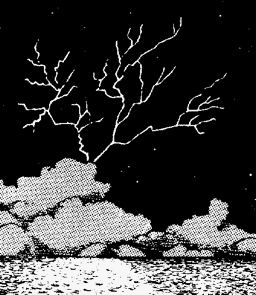 |
Science Frontiers ONLINE No. 84: Nov-Dec 1992 |
|
|
ROCKET LIGHTNING PHOTOGRAPHED FROM SPACE SHUTTLE
 Rocket lightning observed over the South Atlantic in 1964 |
"Video images from space showing a single upward luminous discharge into the clear night air above a thunderstorm were recorded for the first time during the space shuttle STS-32 mission, and later during the STS-31 mission and other missions using the shuttle's payload-bay TV cameras.
"Figure 1 [impossible to reproduce] shows the upward luminous discharge that was seen to move out of the top of a single thunderstorm during the flight of STS-31. This video image was taken at 0335:59 UTC 28 April 1990 while the shuttle was on its 55th orbit and passing over Mauritania, northwest Africa.
"The storm that had the luminous discharge was located at approximately 7.5�N, 4.0�E, and was about 2000 km from the shuttle's position. The lightning discharge was determined to be at least 31 km long.
"We are now trying to understand the significance in relationship to the earth's atmosphere and the global electric circuit."
(Vaughan, Otha H., Jr., et al; "A Cloud-to-Space Lightning as Recorded by the Space Shuttle Payload-Bay TV Cameras," Monthly Weather Review, 120: 1459, 1992.)
Comment. Somewhere 31 kilometers above the thundercloud, there must have been a concentration of electrical charge that acted as a "terminal" for the bolt. How did it get there?
Reference. A more recent term for "rocket lightning" is "sprite" or "elf." These phenomena are cataloged under GLL1 in the catalog: Lightning, Auroras. For a description of this book, see: here.